#given the complexity of the topic I tried to reflect what was depicted both in the drawing and in the text as carefully as possible
Explore tagged Tumblr posts
Text
New talking post!

Thank you very much for your comment @marcysredmoon! And this one is for you!
But before I begin, I want to remind you that this post will have the same TW/CW warnings as the drawing (violence, dark content, Partial Nudity, body horror, horror, Implied abuse, abuse, SA, pregnancy), so read at your own risk!
And one more clarification, all the text below is just my personal theories, headcanons and interpretations of Amelie's life based on what was shown in the show in the first five seasons, I haven't watched the sixth season yet. So if you disagree somewhere - THAT'S OKAY, but please, don't come to me and start fighting u_u You can always just pass by the content you don't like. But I'm not against discussions/questions (after all, there is a block button lol).
So here we go!
Amelie had always been an obedient and convenient daughter for her parents. She didn't mind being "second" (considering Emilie was the heir Initially), and it didn't seem like she could do anything against it when all the weight of responsibility fell from her sister's shoulders onto her own.
And since neither of the twins was a boy, of course, the parents saw in Amelie only a future object that would give them offspring and an heir, provide them with a son. For the parents, Amelie was nothing more than a tool, a beautiful toy.
And in the art, the strings, like those of a puppet, hint at such a life for Amelie. Just as she was a weak-willed puppet in the hands of her parents, she remained in the hands of her husband.
Colt, the man who took Amelie as his wife only to increase his wealth, also expected to receive from such a beautiful girl an equally beautiful heir. As a tycoon who made his fortune in weapons, he was not a very empathetic person. He has a wife. And that means she has to be convenient and beautiful. And she has a "marital duty". And no right to say no.
In the art, Amelie's naked body is COMPLETELY covered in bloody male handprints.
We know that Amelie, like Emilie, struggled to have a child for a long time. And we know that both couples tried literally everything in the hopes of changing the situation. And we also know that even despising "magical intervention", Colt forced his "normal" wife to carry and give birth to their "normal" child naturally.
It was never about Amelie's wishes and feelings, only about her parents, about the husband imposed on her. But not about her. Colt was the one who paid for Felix's creation, but Amelie was the incubator who had to carry him inside her body.
In the art, we see a peacock peeking out as if through a broken shell, which was placed inside Amelie without her permission. "Broken shell" - a bleeding wound on the stomach, the "child" cannot help, but causes pain. (But we know that in the end, Amelie doesn't hate this little baby bird. He didn't ask to be born and he's not the root of all her endless suffering.)
The red colors are chosen to emphasize the pain and agony that Amelie is in. And only the peacock, the child, has another color in her life...
aaaaaand I think on that dark note i'll leave you!
in the future i would like to draw more art related to this topic (and i like to reveal the story through drawings more than through such a text-post), but i think it is better to share ideas at least in this way, than to always put it off for later and in the end never draw anything at all~

The Burden of the "Good Princess".
#for starters I think there are quite a lot of letters and a long post#and as usual SORRY FOR POOR ENGLISH <\3#my asks#sort of#tw violence#tw dark content#CW Partial Nudity#tw body horror#tw horror#TW Implied abuse#tw sa#cw pregnancy#felix graham de vanily#amelie graham de vanily#artists on tumblr#ml#miraculous ladybug and chat noir#miraculous ladybug#Miraculous#mlb#ladybug and chat noir#miraculous peacock#felix fathom#colt fathom#and I would like to draw your attention to the fact that#given the complexity of the topic I tried to reflect what was depicted both in the drawing and in the text as carefully as possible#since this is not about sеxualizing what is happening or enjoying suffering#This is about pain about a woman and um about pregnancy
57 notes
·
View notes
Text
Fairytale Complex - [Undertale | Sans x Reader]
[Gender Neutral, Frisk's Parent Reader | Slow Burn]
Chapter Ten | Dating Fight! (Part 1 of 2)
[First] | [Previous] | [Next]
(Obligatory) Alternate Title: "Ya like jazz?"
• • •
If you told your past self you would be in the monsters' home at midnight, wearing borrowed pajamas and staying the night on their couch, you would've most likely been asked over what the hell you were smoking.
It's what you assume will be a sleepless night, giving you time to reflect on what's happened so far and what opportunities you'd lost with the blackout. Not only had it interrupted your time with Toriel, but it had brought upon a new piece of information you weren't quite sure what to do with, and that was Sans and him being afraid of thunder. While one side of you wanted to tease him over it, the other -- based on how raw his fear was and how much he seemed to have entrusted his safety on you -- wanted nothing but to try to comfort the monster over the situation. In short, sympathy towards him sounded hard to do without him taking it as the results of his flirting, yet making fun of him made you feel like a jerk.
"Can we talk?"
You look to the voice to see Sans standing by the television, a hand gripping its top for stability. His body language shows exhaustion and nothing more, though you don't let your guard down yet, still wary over any possible flirting attempts. "About the blackout thing, I mean."
The circles under his eye sockets are darker than before, a bit of a strange observation to take in, considering how much he's slept already. If this is what he meant about how he needed Karma for his magic, it made way more sense now. A half-hour trip to Toriel's with him casting a see-through veil over the windshield and another one for him to pick up Papyrus had proven more than enough to drain his magic and all the energy left in him.
But if that was the case, why did he accept his job as a sentry, if his task was to kill any human who crossed him -- right from the start?
Was he willing to sacrifice himself for the sake of obtaining that soul, and simultaneously, his kinds' freedom?
"Sit with me," you offer, caught in the spur of the moment. "You already sat on my lap, didn't you? Why try to be modest now? I wouldn't have minded that much, if you'd at least taken me to dinner first."
You hear him snort at that, though a hand covers up the noise when he catches just how quiet everything is. "Sorry, (Y/N). I may like flirtin' with you, but physical contact's where I cross the line. And unless you're also comfortable with it, I'm not gonna try anythin' like that." He rubs the back of his skull, looking guilty. "So with that being said, sorry for all that. For, uh, slammin' right into you, huggin' you, and then, well... lettin' me sit on your lap without asking. I wasn't myself back there."
His expression's not far from that of a wounded puppy, and it's only when you pat down at the space left next to you that he reacts, sitting down and facing your gaze. "Did something happen in the past? Were you… in a war or something like that?" PTSD's the first thing to come up into your thoughts, though you're not exactly sure how to approach the topic with him. "You don't have to answer me, if you don't want to."
"Thanks," he says, shoulders kept high as he huffs and faces his lap. "It's... somethin' like that. But like you said, I don't really know how to talk about it yet." He lets out a noise between a chuckle and a nose flare, meeting your gaze again afterwards. "I didn't know just how… how loud thunder was here at the Surface, so when it first happened, I was even more caught off guard by it. Today wasn't that bad, and I already knew what was comin', but I still acted that way."
"Do… Do other people know about this?"
"Only Tori and my bro. They were the ones who saw me in that state the first time."
You bite your lip and let out a sympathetic hiss in response to that, remembering just who'd caught him and you in that position. If Alphys and Undyne really didn't know anything about his fear, then judging by the wide stares they were giving you while the skeleton sat on your lap, their point of view was clearly far different from yours.
"What's wrong?" he asks, mirth returning to his voice.
"Remember when you sat on my lap?"
His face falls, tone straining with it, "Is remindin' me a way of you gettin' back at me for what I've done?"
You huff and swat his shoulder in a harmless, playful manner despite your narrowed gaze. "I'm being serious here, Sans!" you exclaim, frowning. "Alphys and Undyne... They- They saw us like that, so I was wondering if you knew about it, too."
"What?" he asks, a subtle furrow showing on his skull. "Did they really see us?"
"Yes!" Your response is muffled by you covering your face in shame, face burning at the thought. "If they really don't know about your condition, then they… They probably thought we were hitting it off on the couch!" With how hot your face feels, you're forced to let it go and direct a pointed gaze at Sans, who tries to ease you out with the gesture of his hands and a hush, reminding you to keep your voice low. "They probably think we're dating now!"
"And what's so bad about that?"
"Everything!"
Frustrated by his easygoing self, it takes a minute for you to find some calm, regaining it when you remind yourself over what's more important right now.
"I don't want either of us to get carried away with that, so I'll just tell you this," you speak up, maintaining a calmer tone and looking at the skeleton right in his irises. You focus your eyes on him, wanting the gravity of the situation to be known. "I… I used to be married, and I waited two whole years of dating just to, well… achieve that dream, only to then have Jerry ditch me the second he couldn't keep up with the responsibility of living and raising a child together." You pause in your words, feeling a few tears form in your eyes, embarrassment and sorrow both weighing the same. "If there's anything I need less of, it's romantic drama! I don't mind you flirting with me, but if any false rumour gets out about us, then I... I simply won't allow this to happen anymore."
You back off and lower your intensity.
The more you talk, the more you realize this has nothing to do with the skeleton, aside from what transpired with the blackout.
"What happened earlier was accidental, and I firmly acknowledge that. But if you're going to keep up this flirting charade with me, I'm gonna need to ask for one thing: don't spread false rumours about us." You wipe a tear off your face, looking away when you feel his gaze on your body, burning you. "I… I want to be a good parental figure for Frisk, so if I want that, I really can't be depicted as an easy, airheaded person." You stop and let out a breath, almost shuddering in the process. "I allowed myself to be stupid once, so I can't let it happen again."
You know you're about to confess something really, if not extremely personal, yet you can't prevent yourself from keeping your mouth shut, something about the monster and the quiet of the living room pushing you to be heartfelt with him.
"It was bad enough when he told his friends about how quickly I fell for him -- how it seemed I loved him more than he did with me. And it took me too long to understand what he meant by that when… when his first solution to us not working out the first time was doing a one-hundred and eighty on our relationship without any explanation whatsoever. I was naive and stupid as hell for getting back with him twice after that first fallout, and then deciding to marry him later on, so to this day, I… I still take responsibility for what became of us and our family after that. And that's why I really can't allow myself to… to fall into another relationship just like that. I need to fix this and myself first."
You finish venting with a huff. Then, you form a smile and offer a hand out to the skeleton when you're done. "Think we could both put this day behind us? I won't push further over what happened to you, but I… I expect the same kind of respect and treatment from you."
Sans takes your hand, completing the shake. "Ya really gotta ask, pal?" he says, winking. "Respect's somethin' that should be given right from the start, so long as the other person's showed it, too." He pulls his hand back, meeting with your eyes afterwards. "I may like teasin' and flirtin' around with you, but I still hold respect for who you are as a person, just as I hold respect for how mad attractive you look in your work uniform."
Truthfully, his last sentence catches you off guard with how nonchalant he is, and you almost pass off his words as nothing. But when you do catch onto the comment he made over that particular aspect of you, you stand up, towering over him with your hands on your hips and a scowl. "Good-night," you bark, teeth gritted.
"Wait."
Just as you turn to leave, he tugs at the end of your pajamas' sleeve and grabs your attention with the call of your name. A muffled, jazzy tune followed by yelling and fighting can be heard from the television, now on. "Watch somethin' with me," Sans says, serious. "I know ya ain't sleepy yet, and that you chose to sleep on the couch, so don't leave."
You don't budge; rather, you sigh and keep your back turned to him. "Unnecessary comment leads to a necessary need to retreat."
"C'mon," he pleads, letting go of your sleeve. "I won't make any more of those 'til the sun rises."
"...Promise?"
"Promise."
You finally face him again, though all while keeping a neutral look as you sit down next to him. The television displays a black-and-white film, action present in every second of it. When the monster asks over what you'd like to watch, you don't give him a concrete answer, letting him choose instead. He passes by a few channels, sound clips amalgamating with each other as he switches back and forth, only stopping when a DreamJobs movie shows up, a bee pun quickly making its way to your ears.
"Wanna watch this?" Sans asks, waiting.
"Whatever you want, honey," you reply, arms crossed as you look him in the eye, attempting to one-up his past flirting attempts. "I bee-lieve I told you to choose, didn't I?" You wink, soul leaving your body when you see he grins at your actions.
He returns these by hooking an arm right behind the couch, leaning in just a bit closer to your side and staying true to his word by not once touching you. "Flirtin' back now, huh? Surprised you didn't just tell me to buzz off."
You stare at him for a good while, stricken by his line of defense. When you're capable of moving again, you stand up and make way to the kitchen, only stopping after reminding yourself over how helpful Sans had been these past few weeks, and how little you'd shown your gratitude over it. "I'm gonna go get some water. Do you need anything, Serif?"
"You're all I need right now, pal."
"I'm serious."
He chuckles, slumps on a corner of the couch, and rests an arm behind his skull. A subtle grin returns to his face, sly and dangerous. "I'm good," he says. "Though it wouldn't be bad if you could take some monster meds outta the bottom pantry."
You frown at that, reminded over his physical state. "Are you still tired?"
"Nah. Just got a lil' headache, is all."
Though unconvinced, you enter the kitchen and follow his instructions as to where the medicine is. You take the one marked with 'acetaminophen for monsters' and bring two cups of water along with you -- tap for you, and from-the-fridge for him. Taking a cup of water from Toriel's home made you feel bad, even if it was lukewarm and from the tap.
When you return, you sit next to the skeleton and offer him the medicine first. Then, you offer him a glass, though he takes the warm one. "Think I didn't see what ya did there?" he comments, winking. "You ain't gotta restrict yourself so much, pal. You're as much of a family as Frisk is."
You grab the remaining glass and hold back your emotions, how hard they hit making you drink the water to avoid them. "...Thank you, but I'm not." You drink the rest of the water, not wanting to let your voice waver. "Frisk may be like your family, but I certainly am not."
The movie distracts you when Sans decides to look at you; the mood of the film's far more whimsical and upbeat for your current state of mind. "Like I've said before, please don't waste your time on me, 'cause it's not gonna work."
Silence stays as you both watch the movie, yet it's promptly broken when he finishes his drink. "'Fraid that's not gonna work with us, (Y/N)." His voice is serious again, a rarity for who he is; or at least, who you envisioned him to be. "Just as we're insistent on Frisk being a part of our lives, we're insistent that you can be a part of that, too. It might take time, but it'll happen with effort, integrity, and mutual understanding."
[First] | [Previous] | [Next]
• • •
Tag List (Comment or message me if you want to be added to [or removed from] it!)
@the-simp-express
@nektotersh
@disastrous-l0vebug
@therealchickenjoe
@mintyflakes025
@pandaquick
#sans x reader#undertale x reader#lgbt#lgbt themes#gender neutral reader#male reader#female reader#mother reader#father reader#parent reader#chubby reader#long fic#romcom#adventure#mystery#platonic relationships#slow burn
33 notes
·
View notes
Text
The Final Curtain: Why Sherlock Failed Me
A couple of hours ago, I watched my first Sherlock AMV since I quit the fandom last year. And I realized something: I was more interested in the music than in the actual video footage. I still care about Sherlock and John as characters, but it felt like meeting a friend that I fell out of contact with. I was mildly interested in knowing how they were doing, but I couldn’t bother to be annoyed about their fate anymore. Nowadays, I feel much closer to other fandoms. At the same moment when I realized this, I also noticed that my head was much clearer than when I wrote my last meta on the show. I was rather unfair to Sherlock back then, and although it’s a distant memory, I would like to pay tribute to the joy the show once has given me.
I came for the quirkiness:
Sherlock was not meant to be such a large production: It was a three-part special, dedicated to the works of Sir Arthur Conan Doyle, and as such, the budget did not allow for bombastic special effects like the big explosions and gun fights in the Downey Jr. movies. The closest the show came to “special effects” were some random words floating around mid-air, and this is typical of British adaptations. Around 2010-2012, there was another pseudo detective show of similar down-to-earth character: Dirk Gently. Both shows prove that you do not need giant fireballs hurled at the protagonist to make the audience care for them: It’s the characterization, not the story, that drives these shows forward.
Sherlock aired at a time when detective shows turned extremely dull, because they were competing in gruel depictions rather than in complex protagonists. It is enjoyable to watch two characters have a seemingly pointless conversation over dinner, because this is something that would get cut in more commercially oriented shows. Sherlock defied the formula of “corpse, investigation, solution” by offering multiple cases or telling us the identity of the culprit, but not the reason. Since it was three episodes, they got away with it: People would either watch all or none. There was no need to make it easier for casual viewers to enjoy the show. It is a piece of self-reference and experimentation. Honestly, I doubt this show would have attracted that much attention if it were not for Cumberbatch and Freeman. Dirk Gently also breaks with a lot of traditions, but its leads are not as aesthetically pleasing to the masses, I guess.
Sherlock was quirky. It was essentially British; it was stubbornly refusing to let itself be categorised as a drama or a detective show or a comedy.
I stayed for the drama:
The second season had big shoes to fill, especially since there was no true storyline yet. The first season was just as much an iteration of disconnected events as most of the short stories. However, Sherlock seemed to be there to stay, and that is why the writers had the guts to go one step further. In the second season, they would build up towards a full dramatic arc: Moriarty would truly be involved, not just some hinted shadowy figure. This way, the cases would be personal. The focus shifted towards the interpersonal relationships between the characters, and this also explains why Mycroft was suddenly pulled to the front. Any progress, any obstacle during the investigations had to be connected to the human network surrounding the protagonists. There was no room for chance, for some outside force. The second season is built on drama, not on cases. Instead, the characters are pitted against each other.
I fell out of love when the show reoriented itself:
During the great hiatus, I consumed a lot of fanwork, and, admittedly, this raised my expectations of the third season. There had been a lot of predictive meta, a lot of great fan continuations. In truth, Sherlock had no chance to live up to the hype. There was no way they could cram Sherlock’s return, fiendishly difficult cases, a homosexual relationship, a sob-story past for Sherlock, a credible theory for Moriarty’s survival and a drama arc concerning John’s alcoholic sister into three episodes. The average post-s2 story covering these topics is about 150 k words!
No, season three was fated to disappoint, because it could not possibly satisfy all the subgroups of the fandom. Due to the previous multi-facetious approach, there were shippers, there were genuine Holmes fans, there were those that were in for the human drama, and those that simply liked detective shows. Additionally, the show had crossed a lot of borders: The writers were no longer writing for the BBC, but for the world, which means that cultural quirks only work to a certain degree before they become incomprehensible or unacceptable.
And that’s when the writers lost me, somebody who joined the fandom for the original pilot, not the drama of the second season (although it was an added benefit): They decided to reorient the show, to make it more mainstream, more accessible. At the same time, they felt obliged to satisfy the “original” crowd by offering us meaningless references to the past. They attempted to do a little of everything. They would hint at Johnlock, they built up a mastermind villain who fell short at the decisive moment. They gave us a great return drama, but glossed over the emotional upheaval because… time. The off-switch on the bomb, that’s essentially the off-switch to the drama. They had to move on to the next fan wish. Sherlock was hurt badly, which satisfied the whumpers. They tried their best to address all the needs, at the cost of being indecisive, yes, baiting, even. It became virtually impossible to pick a main theme running through the season, because they poured all the ingredients into one giant bowl and mixed them until it the distinctive flavour of the original products is lost.
Season three is not a good example of a homoromantic forerunner of its time, because the Mary arc destroys the message.
It is not a good example of a continuation, because it fails to address the questions left unanswered by its predecessor.
It is not a good example of detective show, because the cases are not presented as the main attraction. It is difficult to guess alongside Sherlock without being given the necessary clues.
It is not a good example of a drama, because the dramatic turns are not addressed in terms of their consequences. Sherlock’s fake death remains without lasting consequences as does Mary’s attempt at murder, and let’s not mention Magnussen’s death.
Season three has so much to offer, but essentially, it fails to find its own theme. The characters and plots are yanked all over the place to fit the new audience’s demographics.
As soon as I sobered up, I quit:
I cannot say much about the fourth season, only having watched the first trailer. However, the interviews and spoilers showed me that the cast were extremely pleased with their previous achievements. I doubt they reflected how much their show had changed, and especially their comment on how they were able to create the show they had wanted to create helped me sober up. By this date, Sherlock had become a highly commercialized, close to mainstream work drama. If this was truly what the writers wanted to create, then season four had nothing to offer to me.
I no longer suffered from the illusion that Sherlock would address the flaws of the third season or return to being about crime solving. At this point, I had turned into a serious Johnlocker. To me, it seemed the only way to save the show from becoming forgettable. If it could not become a legend from an in-story perspective, then it could write history for the depiction of a homoromantic relationship on a large scale. Sherlock attracted a huge audience in countries where such topics are highly problematic. It seemed like such a good idea to use this falling star as a missionary for social awareness. Since Brokeback Mountain, the depiction of gay people in the media has increased, but it is still about stereotypical behavior, and usually, these people don’t experience a lot of happiness. It would have been nice to watch a show that would address the issue in a subversive way. That would have been modestly refreshing.
However, I realized that there would be no grand scheme to put forward a message to the society. No, just another three episodes of mainstream explosions, gun fire, pointless squabbling to create drama, and some backstory that would please the whumpers. Of course, Mary also had to die after giving birth, which satisfies the haters and invites the fluff fans to praise the resolution of the arc.
Sherlock had, essentially, become predictable. And predictable is boring, because it’s exceeding the expectations that makes a show great.
And now?
Am I disappointed in Sherlock? Actually, no, I am not. I suppose I had been disappointed last year, but since then, I moved on. I’ve accepted that I am a picky viewer, and that this was just another failure in a long list of forgettable shows that did not live up to my high expectations.
Addendum:
By the way, there’s a Japanese show that recently had the guts to portray a gay couple without a tragic end or defining the characters by their sexuality: Yuri on Ice. The protagonists are professional figure skaters and the show is mostly concerned with their work experiences. It is a well-written and highly popular sports series, in my opinion.
I am somewhat surprised that the very conservative Japanese managed to beat us when it comes to this.
6 notes
·
View notes
Text
Fader: Meet Zahira Kelly, The Black Latina Artist Painting Black Women As Goddesses
The Georgia-based artist’s work places Black women, Negras, at the center of historically white Catholic symbols.
The art world can seem very white, depending on where you're looking. So can the Catholic church, where, when I was a little girl, my Cuban and Dominican relatives would take me on rare Sunday mornings.
The churches we went to were boring, and painfully white. Everyone spoke Spanish, a language my entire family speaks fluently, but which I'm not great at. I would often tune out and gaze at the (very white) art that decorated the windows of the church. I didn't see myself, a Black Latina, reflected there, and I couldn't articulate why I felt like I didn't belong. These were my "people," and yet, they all looked and spoke like they were from a different universe.
Georgia-based artist Zahira Kelly’s work places Black women, Negras, at the center of historically white Catholic symbols. A Black Dominicana, Kelly has been drawing since she was "able to hold a pencil," and has been making custom art for underrepresented Black girls for the past couple of years. Her work highlights the magic of Black women, painting them as celestial princesses who know they're too good for you.
I spoke to Kelly over email about navigating through the art world as a Black Latina, how "AfroLatinx" has become a colorist term, decolonizing nudes, and why Cardi B would be perfect for the role of Suicide Squad’s Harley Quinn.
When did you start drawing illustrations?
Art runs in my family. My mother is multitalented, so is her sister. I was raised by them so it all came naturally. My daughter is also great at it. I was drawing as soon as I was able to hold a pencil and women have always been my focus. That’s who I am and who was and is important in my life. I started doing it professionally in my mid-20s. After searching high and low for Black pinup art and finding nothing, I decided to make my own. I casually posted one to an online community of Black girls I was part of and suddenly I was doing custom art for other underrepresented Black girls.
Thinking about your Virgen Negra collection, placing Black women in place of these historically white Catholic symbols, what was inspiration behind creating these?
Catholicism is a part of many Dominicans upbringing and I was no exception. For me, depicting La Virgen as a Negra is fusing our African ancestry with Catholicism like many in our country have done before with spiritual figures. It is also a question: Can you see lower class Black women as the Holy Mother in such a classist, anti-Black misogynist postcolonial landscape? And given historical and recent backlash against Black motherhood (see: Beyoncé), I was curious as to what a Black Virgen de La Altagracia with a Black baby Jesus could look like; how it would be received. While the response was overwhelmingly positive, I did get harassed by some non-Black Latinxs about it. There’s a direct correlation between historically white-leaning standards for Latin American women and rage at the Holy Mother being depicted as Black. So, to quote Bey, “I ain’t sorry.”
Zahira Kelly Courtesy of the artist
“In both my art and writing I simply want to exist freely. To exist, period. That is so elusive when you are a Black LatinAmericana.”
What has your experience been like in the art world, being a Black Latina navigating through these spaces?
I have often been relegated to niche. Depicting only white bodies is considered universally accessible, relatable art. Depicting Black bodies is considered niche, close-minded, even racist. But luckily life is a bit more complex so I have art collectors and patrons from all racial backgrounds and walks of life. Turns out Black girls are humans and thus very relatable.
A lot more people are becoming informed about Afro Latinidad. Do you think the definition of "Afro-Latinx" has changed? If so, why? Is there a difference between that identity and that of "Black Latinx"?
“Afro-Latinx” has now been co-opted by Latin Americans who do not get read as Black in daily life. To where they’re telling visibly Black Latinas they are too Black to be Afro-Latina. Somehow a term for Black pride became colorist and anti-Black. Which is the same horrifying erasure and convolution of our work we sought to avoid when we created that identification. Can’t have nothin’ nice. I am ready to leave it to their trifling asses. I’ma be Black anyway. Have fun being an anti-Black mind-fuck.
"Nude II" Zahira Kelly
“Depicting only white bodies is considered universally accessible, relatable art. Depicting Black bodies is considered niche, close-minded, even racist.”
"Nude III" Zahira Kelly
For the Nude Series, why did you decide to include talking bubbles ("I can't believe I gave you all this for free," "You never deserved this glory," "I'm too good for you")? And in general, what was the inspiration behind this series?
Nudes are such a contentious topic. They’re referred to as slutty, self-objectification, or for the male gaze; they’re weaponized against women. For many Black women and Native women in the West that is a very colonial notion, that nudity is sin. Colonizers found us topless and nobody used that as an excuse to rape or call us hoes until they got here.
In this series I sought to complicate that [notion] and instead show Black women who are historically devalued, speaking on how extremely valuable they are. They’re odes to self-love when the colonized, enslaved world has tried to tell us we are unworthy of any love at all for 600 years. There are several more pieces to the series. I am exploring my options to exhibit the rest of them in the near future.
"Galaxy Princess III" Zahira Kelly
“We are walking universes. Booty shaking is part of our ancestral lineage and retained through hundreds of years of violent suppression and repression.”
For the Galaxy Princess series, what was the inspiration behind putting these figures in motion (twerking, etc)?
It was initially inspired by a video clip going around Twitter of a dancer twerking in glittery galaxy bodypaint by @bodypaintking on IG. I was mesmerized at the sheer Black Girl Magic. And then I studied videos of Miss Twerksum to draw the figures. They shaped up to be a celebration of Black femmes cultural dance, sexuality, magic and glory. We are walking universes. Booty shaking is part of our ancestral lineage and retained through hundreds of years of violent suppression and repression. We and our ass-shaking matter.
What made you paint Cardi B as Harley Quinn?
First off, I’m a huge Cardi B fan. She needs to be canonized. My friend @twittahoney mentioned Cardi B should’ve played Harley Quinn in the Suicide Squad film. After watching it, I also decided a witty, mouthy Dominicana from the Bronx popping gum in sneaker heels, swinging around a baseball bat would’ve made a lot more sense. I don’t have “cast Cardi B in whatever I want” money, but I can draw her as Harley Quinn.
"Cardi B as Harley Quinn" Zahira Kelly
Who do you hope to reach with your art? What do you hope to express?
In both my art and writing I simply want to exist freely. To exist, period. That is so elusive when you are a Black LatinAmericana. Our mere existence is a point of contempt and topic of debate. I do what I want. I depict my life, my interests, my thoughts, because I finally realized I am allowed to as a human. We spend our lives consuming media and art for and by anyone but ourselves as Black Latinas, so I am always happy to hear others can identify or are inspired to also express their own life and assert their existence. Sometimes simply being visible is resistance. And I’m ever grateful for having found support in my creative ventures.
Check out Zahira Kelly's art on her website.
1 note
·
View note
Text
Summertime in Gràcia: 200 Years of Street Decorations
I guess it would be strange to write about my time in Barcelona without mentioning the terrible tragedy that occurred there. Yes, Barcelona, my second home, was brutally attacked while I was visiting. In fact, I was just in Las Ramblas not too long before. And while I am so thankful that neither me nor anyone I care about was injured or even directly affected, my heart still breaks for Barcelona. It's an indescribable feeling, but there's something about Barcelona that makes you feel so incredibly safe. For example, most big cities have a kind of 'sketchy' night scene. Barcelona does not to me because there are all sorts of people walking around until 2am in the morning. Old, young, female, male, and all types of ethnicities. It feels safe. And now, I don't know what to think. I still believe Barcelona is not dangerous, but my world changed. Nonetheless, I'm really happy to share Gràcia with you. I originally came to Barcelona in burning August because I wanted to see the Gràcia festival. Victor had been telling me about all the decorations and festivities at this time of year. And this year, I finally got to go!

I've organised this post by the winners, starting from the bottom and landing with the best I saw. Get ready for lots of colour!
22nd: Sant Jordi
I know a lot more about Sant Jordi/St. George than when I did when I took these photos. Sant Jordi has a famous legend across Catalunya and some unique traditions to promote the holiday. Like many Christian saints, Sant Jordi has his own holiday. In Catalunya, it is a tradition for gifts to be given on Sant Jordi's Day. It has turned into a kind of Valentine's Day alternative. Historically, men gave women roses, and women gave men a book to celebrate the occasion – "a rose for love and a book forever." In modern times, the mutual exchange of books is also customary.

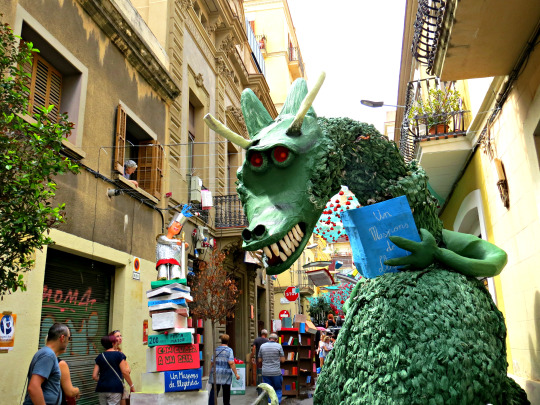
The legend behind Sant Jordi is that a terrible dragon terrorised the town. In exchange for peace, the town had to give up one of its own people everyday to the dragon. Finally, the King's daughter was sent as a sacrifice. Sant Jordi saved the princess and slayed the dragon. This is why Carrer Maspons is decorated with a dragon, roses, and books. It all makes a lot more sense now, am I right?

21st: The Romani People
I passed by this very quickly because the sun was starting to burn and I had so many more streets to see! Plaça del Poble Romaní was actually quite interesting because it was dedicated to the Romani people of Barcelona. It was filled with music, snacks, workshops, and many things dedicated to the culture of Gypsies.
20th: Candyland
Carrer Berga put on a wonderful display of a candy shop in a circus-like atmosphere. Lots of colour, lots of fun! Filled with cakes, caramels, chocolate, and lots more sugar, this street was adorable.



19th: Without Borders
Carrer Ciudad Real went for a really interesting theme, perhaps one of the most in Gràcia this year. 'Without Borders' focuses on those who have escaped their homeland for a better place. There is a beautiful poem describing the theme and basically the message is that the world is full of borders, and those who struggled to cross those borders should not be forgotten. Borders are just borders, and such borders should not stop people from looking for a better life.



18th: Seaside Town
An interesting choice, Carrer Placeta de Sant Miquel i Rodalies (I know, a mouthful!) chose to copy a seaside town. The decorations are about the Mediterranean and the countries along it including Italy, Greece, France and parts of Spain including Catalunya and Valencia. The idea is to depict the daily life and characteristics of these seaside towns. Complete with hanging laundry and a busting market, Gràcia has its own city by the sea! It also reflects the refugee crisis which has impacted the Mediterranean. Often refugees come from Morocco to Spain, from Turkey to Greece.
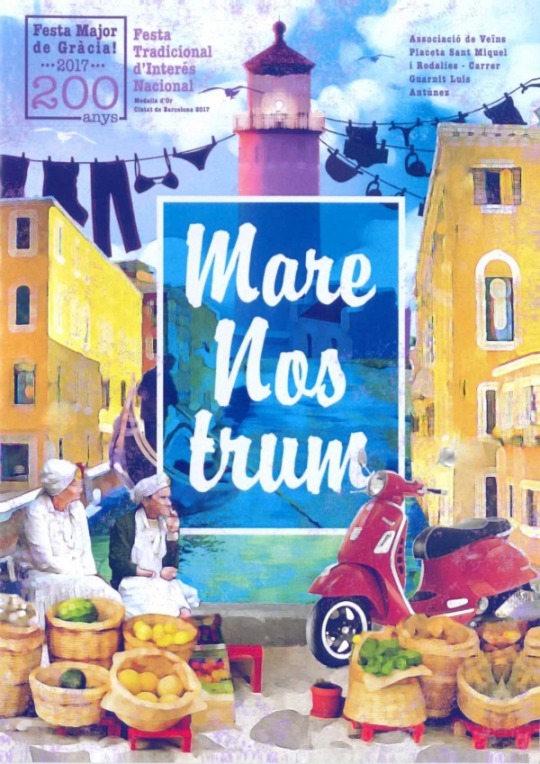

17th: Off to the Circus
Carrer del Perill was actually the first street I ventured into. Circus-themed, I loved the simplicity and unity of this street. There were so many little details, like the tickets hanging from above and the activities for children.


What's even cooler about this street is the fact that they paid homage to their own Circus theme from 1950.

16th: Rock'n'Roll
What would rock and roll be without ambition, craziness, danger, and fun? It would be nothing and hence why it is still important to many people even today. I admit I never listened to my dad's old rock 'n' roll vinyls... I listened to his classical music vinyls because I was that weirdo. But I've learned so much about rock 'n' roll since many stars have passed away within the past couple years. Carrer Mozart paid a great tribute to a great era. It was also just a really fun street!
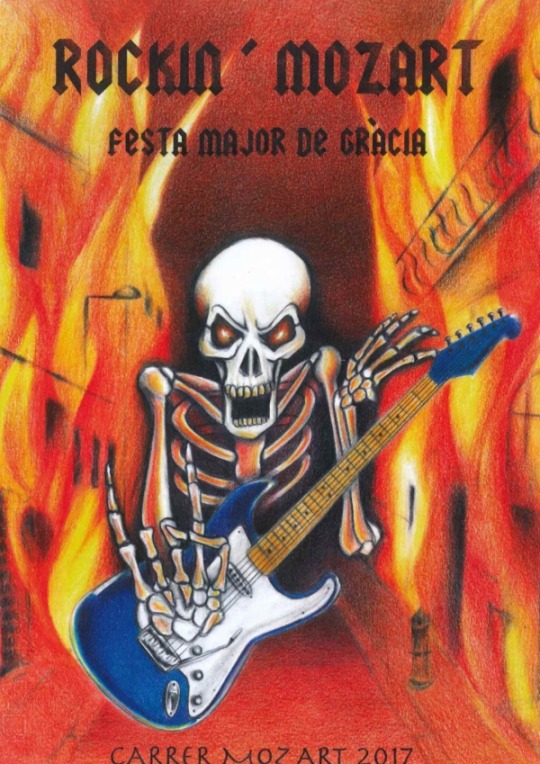

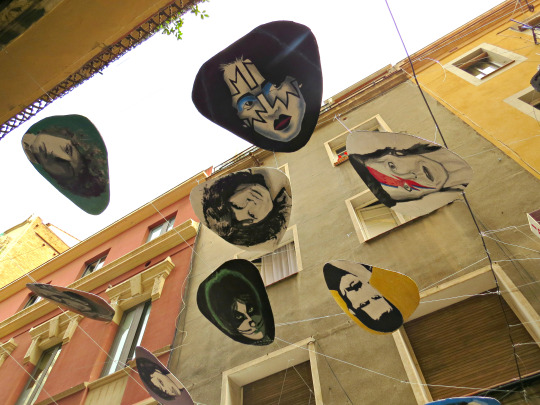
15th: 60s
Perhaps it is not too surprising for this theme to come up, but yes, Carrer Providència put on a 60s theme. It is stock full with peace symbols, colours, flowers, and happiness all around.
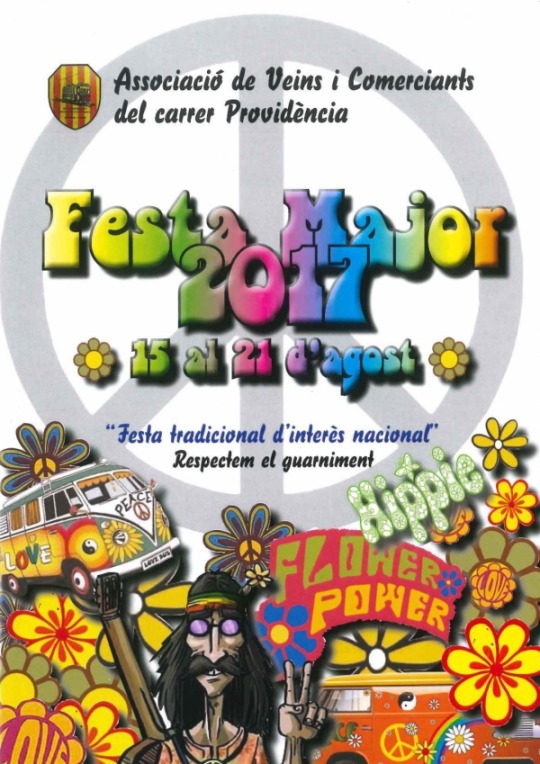

14th: Da Vinci
Simple but beautiful, Carrer Tordera put on a Leonardo Da Vinci street. Little details along the street made it spectacular, like the equations, gears, and wheels.


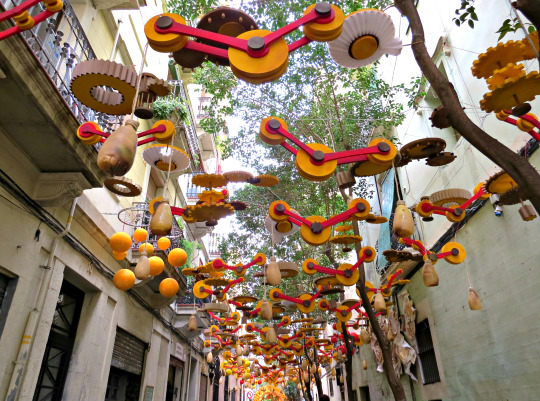
13th: The Little Prince
A charming and thoughtful presentation Plaça de la Vila (one of the main squares in Gràcia) picked The Little Prince as its topic of choice. The theme was 'The essential is invisible to the eyes,' inspired by the Little Prince. It tries to depict the drawings of Antoine de Saint-Exupéry. The plaça is divided into spaces depicting each of the little Prince’s adventures.
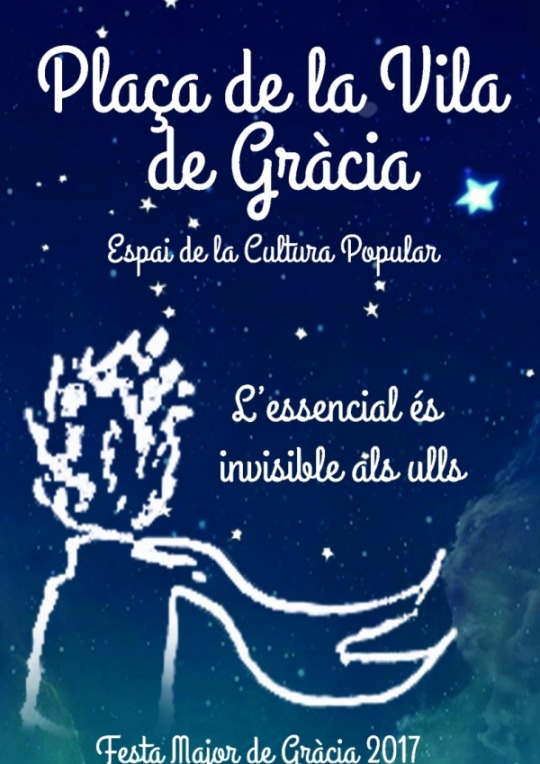

12th: Ghostbusters
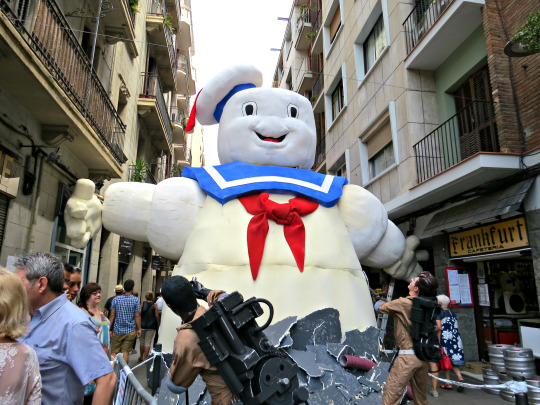

Now Carrer Puigmartí put on a great display which was a lot of fun! Perhaps the most fun!
If there's something strange in you neighborhood Who you gonna call? Ghostbusters! If there's something weird And it don't look good Who you gonna call? Ghostbusters!
It was based on both the old and new versions of Ghostbusters. The finale with Gozer is shown at the end. Pretty epic!


11th: Punk Flamingos
As evident by the name of the theme, Punk Flamingos is based off of the movie Pink Flamingos. I admit I have not seen the film, but further research shows that it is a transgressive black comedy exploitation crime film with the main character being a drag queen. It is apparently famous for its outrageousness. I mean, we are talking nudity, profanity, and frivolity.
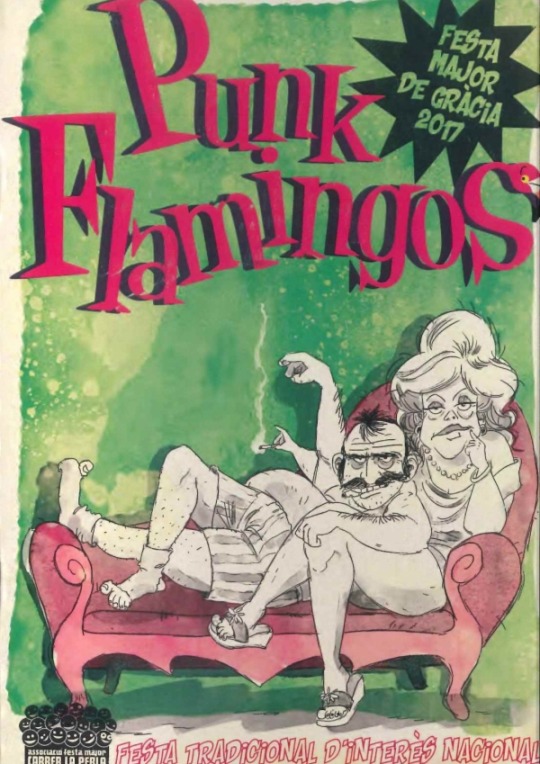

Carrer La Perla played with the theme to include flamingos throughout as well as a giant representation of the main character.

10th: Green It Up!
A street I did not venture into, Carrer Joan Blanques de Baix was an ode to nature itself.
9th: The Neverending Story
My personal favourite, Carrer Fraternitat de Dalt presented The Neverending Story. I saw so many smiles when people walked through this street because I think there's a lot of nostalgia for this childhood staple.



For those of you who may not be familiar with The Neverending Story, it became popular from a 1984 adaptation but the original story is a book by a German writer. The main character is a young boy named Bastian Balthazar Bux who becomes entrenched in the world of Fantasia. Other memorable characters include Atreyu, another main character who is employed by the Childlike Empress to save Fantasia. There is also Engywook and Urgl (two gnomes), Falkor the Luckdragon, and Grograman. It is a truly wonderful world.

8th: Atmospheres
The decorations along Carrer Verdi del Mig were all about the abstract idea of different atmospheres. They create an imaginative world full of colour and texture. They try to focus on the senses so you can experience everything in every way possible.


Typically Carrer Verdi del Mig puts on a pretty impressive display. You can always expect something over the top, hence why the street was so incredibly dense and colourful!

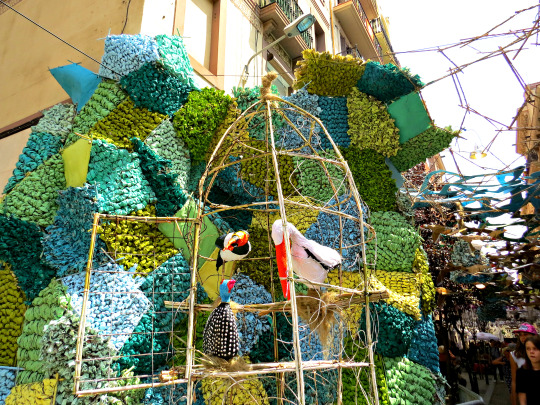
7th: Inferno
Definitely one of my favourite streets, Carrer Llibertat became the Inferno. You enter the devil’s mouth and continue through a dark cave where you see demons and skeletons. Many greek mythological creatures emerge, including Cerberus.
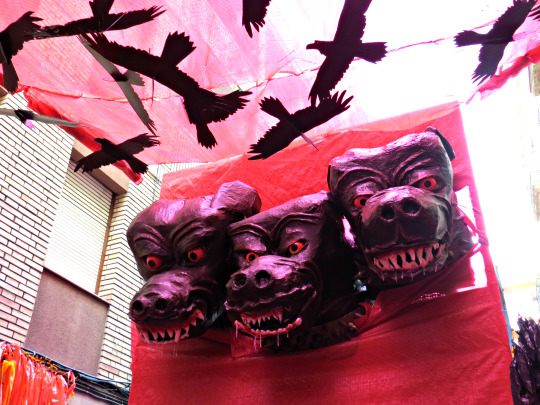

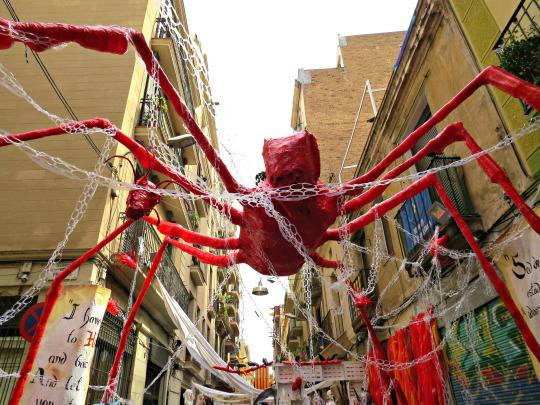
Carrer Llibertat was also honouring their history because 30 years earlier, the theme Inferno won second place.

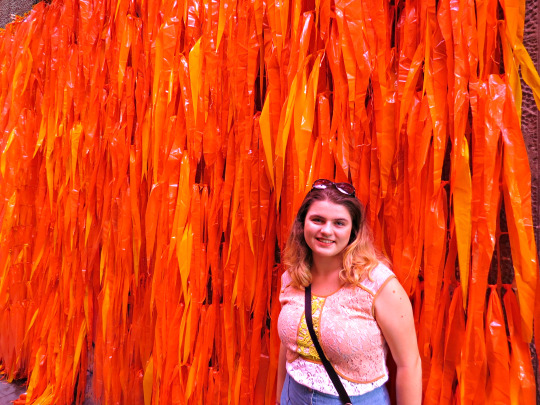
This street was over the top, and Victor and I loved it. I may be biased because I also got to try a traditional Catalan treat Coca de Vidre. Vidre in Catalan means glass, which reflects the bread because it is very thin and easy to break. The name also comes from the fact that when you pour the anisette (anise-flavored liqueur) into the flatbread right after the oven, the mixture of anisette and sugar crystallises. Right before putting on a show, the street organisers passed out boxes and boxes of Coca de Vidre—definitely a highlight of the day!
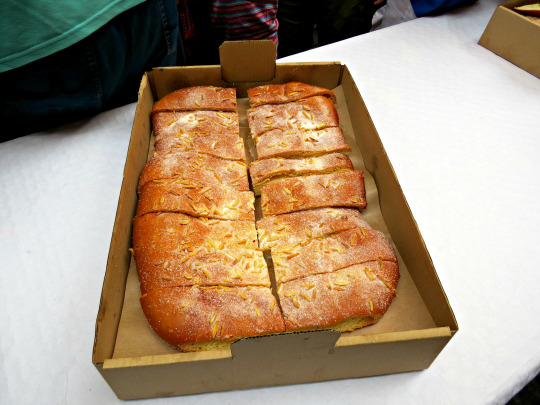
6th: Russian Revolution
Carrer Progrès depicted the Russian Revolution of 1917, marking 100 years since in 2017. It symbolises the end of the oppression of the Czar and the beginning of a new society based on mutual support and the solidarity of the working class.

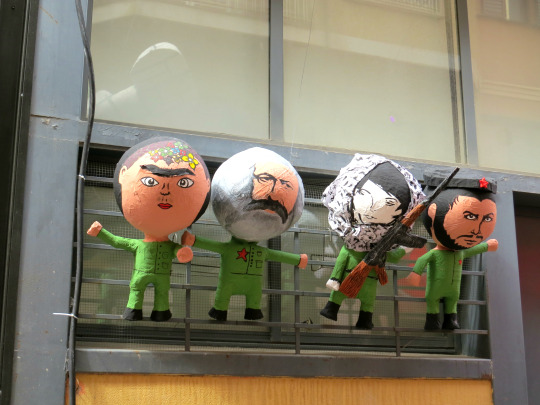
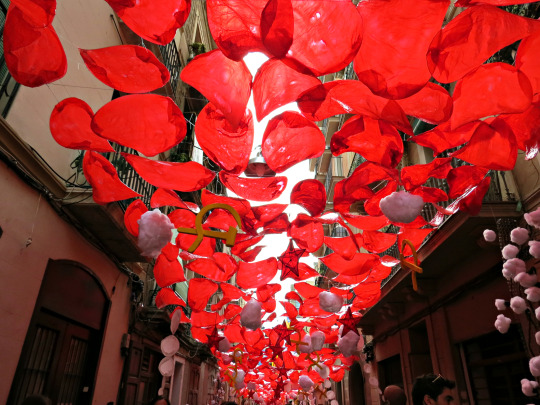
Visitors were greeted by a giant statue of Lenin with a giant Kremlin behind. Inside the Kremlin there was stained-glass made out of cellophane.



There were so many great details throughout the street, like Russian propaganda, different types of workers, as well as symbols from the time.
The finale was probably the best. A cartoon-like scene with Lenin kicking out the Czar with a broomstick. I wouldn't be able to think of a better depiction.

5th: Fantasy in White
"Fantasy in White" took over Plaça Rovira i Trias. This theme was perhaps the most complex in terms of the idea. The decorations play with the colour white, or the absence of colour. It also plays with colour through different constructions. During the day, the decorations will appear white, but during the night they transform to three colours representing the sky, land, and sea.
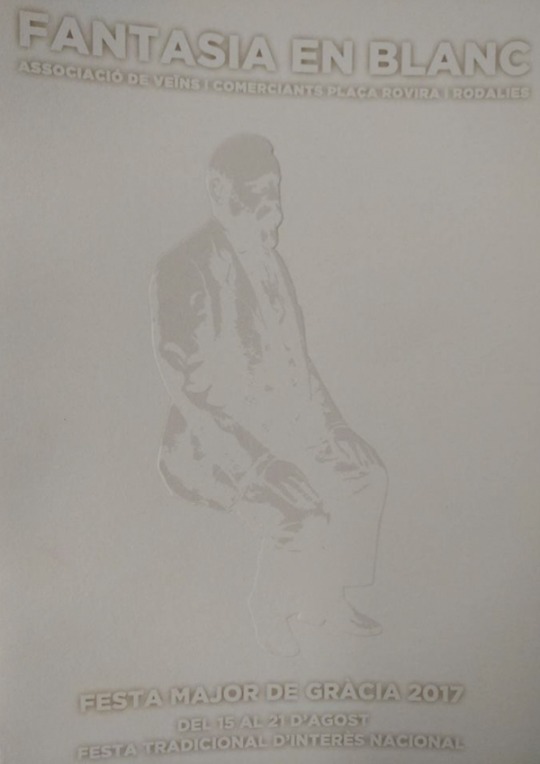

4th: King Kong
Carrer Fraternitat de Baix's King Kong display was definitely one of my favourites. Walking up to King Kong climbing up the Empire State Building was just "plane" awesome.


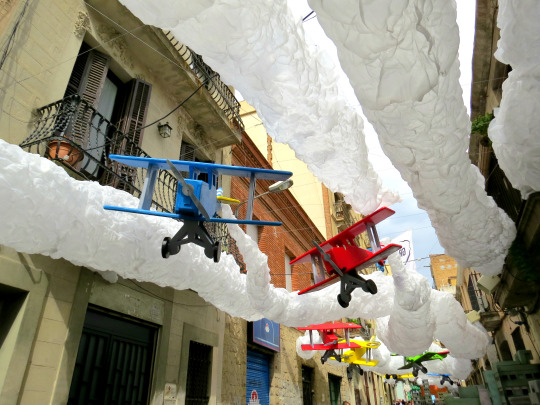
3rd: Metamorphosis
A simple but beautiful display, Carrer Jesús depicted the life of a butterfly.

Once entering the green space, visitors are greeted by bright orange caterpillars. The next phase shows the caterpillars spinning into their cocoons. And finally, the cocoons open to reveal beautiful, colourful butterflies.



The Winners
Ironically, the 1st and 2nd place winners are two of the three streets I did not explore! What are the chances! But in any case, it seems that the winners of Festa Major de Gràcia truly deserved their prizes. Carrer Joan Blanques de Baix came second with a theme centred around 'Once upon a time.' Carrer Travessia de Sant Antoni came first with its Skiing Resort town theme.
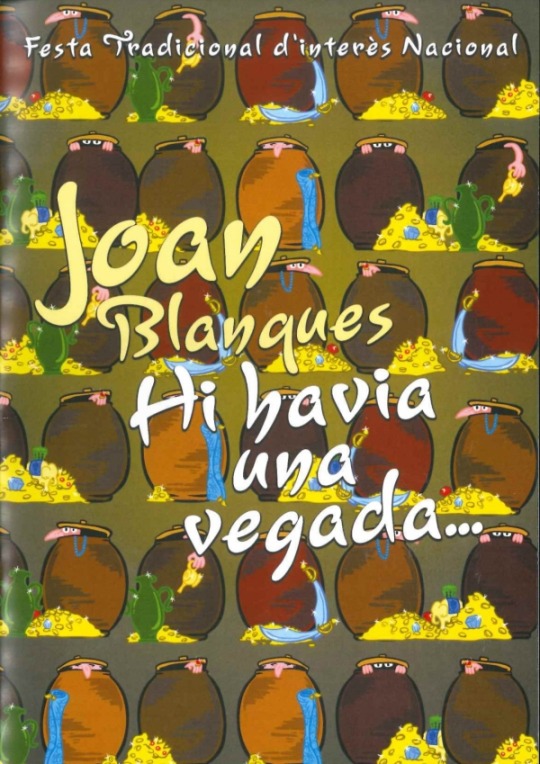

And, I believe it is now appropriate to say: that's a wrap, folks! Though the 200th anniversary of Festa Gràcia was in some tainted by the tragic acts of terror, the streets still stood, the decorations still made people smile, and Barcelona still stands strong. I can't wait till I can return!
0 notes
Photo

DiMoDA 2.0 at the RISD Museum: A Review
Jason Farago of the New York Times recently published “Virtual Reality Has Arrived in the Art World. Now What?” In the piece, Farago discusses the development virtual reality technology in the art world and its cultural implications. He lists numerous exhibitions featuring virtual reality at major international institutions such as the Dulwich Picture Gallery in London, The Jewish Museum in New York, the Renwick Gallery in Washington D.C., the Museu de Arte Moderna in Rio de Janeiro, and the Robben Island Museum in Cape Town. He writes,
Virtual reality, by contrast, is a medium without limits — a medium that tries to parallel life itself. The wonder I felt when I first put on an Oculus Rift, and lost myself in Mr. Steegman Mangrané’s rain forest or Ms. Rossin’s floating world, is undeniable. Now the challenge is to put virtual reality in the service of something more complex, for it would be a pity if wonder was all we got.[1]
The RISD Museum’s latest exhibition, DiMoDA 2.0: Morphé Presence, takes on the immerging medium of virtual reality in new and challenging ways.
I enter the RISD Museum and begin navigating my way to the third floor. Take the elevator up to the sixth floor, make a left, then a right, then straight back, then take another elevator down to the third floor. The directions are confusing, but manageable. As maze-like as it may be in the midst of construction, the RISD Museum is not uncharted territory. However, when I finally arrive at the third floor, I find myself in dark and disorienting place. A small room with dark grey walls lies to my left as I exit the elevator. I enter the room to find three screens: two horizontal ones on the left wall another vertical on the back wall. The room houses little else. There are two dark wooden stools in front of the screens on the left wall. Below the screens there is a gaming console, a video game controller, and large headset hanging from the wall. On the opposite wall, there are two paragraphs of white wall text that give some context for the exhibition. Dark and intimidating as it may be, this space maintains a level of familiarity it its method of display. Despite its novel subject matter and medium, the artwork is displayed as Alfred Barr intended, an accustomed style to museum-goers worldwide.
However, the similarities to traditional museum experiences stop there. DiMoDA 2.0: Morphé Presence is otherwise in uncharted territory, alien to both viewers and curators alike. Invited curators Eileen Isagon Skyers and Helena Acosta are cognizant of this, and thus are extremely generous in the amount of information they give within the wall text. They explain what each facet of the work entails; the wall text informs participants that,
Miyö Van Stenis’s Miyö’s War Room examines how contemporary video games, social networks, and internet culture sexualize women and girls and pressure men and boys into aggressive roles. Brenna Murphy’s Vectoral~Sentience_Stack offers an optically challenging and meditative visual experience, in which the viewer seems to float in a vibrating optical illusion. Theoklitos Triantafyllidis’s humorous Self Portrait (interior) becomes a claustrophobic tour of the internal workings of the human body. Rosa Menkman’s DCT Syphoning The 64th Interval is a vibrating black and white static topography that depicts an image as it is being rendered through encoding technology. While distinctly different in their visual manifestations and conceptual aims, each of these works intertwines formal and conceptual approaches with emergent technologies, delicately balancing criticality, humor, and experimentation.[2]
Despite the curator’s generosity with information about the artwork, Morphé Presence remains an extremely challenging exhibition for participants to grasp. The novelty of the medium as well as the work’s propensity towards confusion result in an enriching, but overall inconclusive experience.
In order to engage with this artwork, participants must don a virtual reality headset and use a video game controller to move around the virtual space. The work begins with the participant standing alone on what appears to be a larger rock floating in a vast and empty outer space. The work instructs the participant to use the left joystick to walk or run across throughout the game. As you walk around the meteor, four additional meteors enter sight, one with a large geometric building with a Neoclassical facade on it, and the others, much farther away, with various indiscernible colorful objects atop them. The human tendency towards curiosity takes over, and you walk towards the building to investigate. You press the X button and leap towards the second meteor, without knowing whether you will land there. After a safe landing, you make your way towards the building and enter through the front façade’s columns. Inside, the ceiling and walls radiate with the light of stained glass. Blues, greens, and purples reflect through the windows and throughout the structure, a striking digital melding of ancient and contemporary architectural styles.
This initial stage of the work is primarily used to orient the participant to the medium. Free to walk around the meteor without obstacles, the participant can explore and take their time to get their virtual footing with the video game controller and watch the 360 degrees of this new world expand around them. The starry sky of outer space provides a striking, but easy to render, visual experience for the participant. The setting of outer space also draws a parallel to the sense of uncertainty with this new medium of virtual reality. Each exciting and liberating, but our understanding of it is still in its infancy. We have no way of knowing how vast the opportunities of outer space are, nor are we privy to the potential prospects for virtual reality technologies. We have little foundation for interacting with either scenario.
Inside the building is mostly open space with rocky outcroppings, however in the center there are four large rock or geode-like structures that glow with blue light. When approached, shimmering boulders begin loading another part of this virtual universe. Miyo, Rosa, Brenna, and Theo, the titles given to each rock, transport you to one of the far-off boulders and thus into a different world. Named after their respective artists, the different worlds have unique imageries and concepts that they address.
Although some of the worlds seem to address a similar state of confusion, others speak to more definitive topics. Perhaps a bit unexpectedly, there is not one discernable unifying concept throughout each world. As a participant, this makes Morphé Presence extremely bewildering. While moving from world to world, there is an expectation of a narrative or at least a central motif. However, this is certainly not the case and results in an intense sense of confusion and even eventual boredom. Additionally, the experience of wearing the virtual reality headset can induce mild to severe nausea, further off-putting the viewer and increasing their overall confusion and discomfort with this new medium.
The lack of a unifying theme throughout the work indicates that Morphé Presence is more of a virtual museum for a handful of artists rather than a single art object all on its own. This is reinforced in the fact that in order to leave one world and enter another, the work instructs the participant to “Go back to the lobby,” as opposed to the “main menu.” This is where the work becomes an art object instead of a video game. The work’s use of the word “lobby” implicates a formal museum setting and insists on its relationship to the physical world. In a video game, however, the “main menu” does not attempt to imply a relationship to the player’s everyday reality. The “main menu” is a digital space, while the “lobby” is a physical one.
After entering all four worlds, there is not much else to do other than take off the headset, put down the controller, exit the exhibition and recede back into normal life. Although there is no one story that the artwork follows it creates an experience of its own that cannot be easily forgotten. The experience of leaving the virtual reality is comparable only to something in between waking up from a dream, and stepping back onto Earth after being on the moon. This exhibition is without question an object of art and should be regarded as such, however it should also be considered for its experiential value.
Virtual reality is valuable not because it is a tool to escape our own reality, rather, it provides us with a basis of comparison. What is different about these various realities? What is alike? What do we want to change? What do we want to keep? And how do the answers to these questions make us feel?
Art in its highest form is an experience for the mind, the body, and the soul. DiMoDA 2.0: Morphé Presence allows the viewer to experience just that. Although the exhibition is overall more confusing than educational or inspirational, it nevertheless provides participants with an introduction to the increasingly prominent medium of virtual reality.
Sources:
[1] Farago, Jason. "Virtual Reality Has Arrived in the Art World. Now What?" New York Times, February 3, 2017, accessed February 5, 2017.
[2] Eileen Isagon Skyers and Helena Acosta, “DiMoDA 2.0: Morphé Presence” RISD Museum, January 6, 2017, accessed February 2, 2017.
#DiMoDA#DiMoDA 2.0#RISD Museum#risd students#review#art#Morphe Presence#New York Times#Jason Farago#virtual reality#oculus rift#Miyo Van Stenis#Brenna Murphy#Theoklitos Triantafyllidis#Rosa Menkman
0 notes